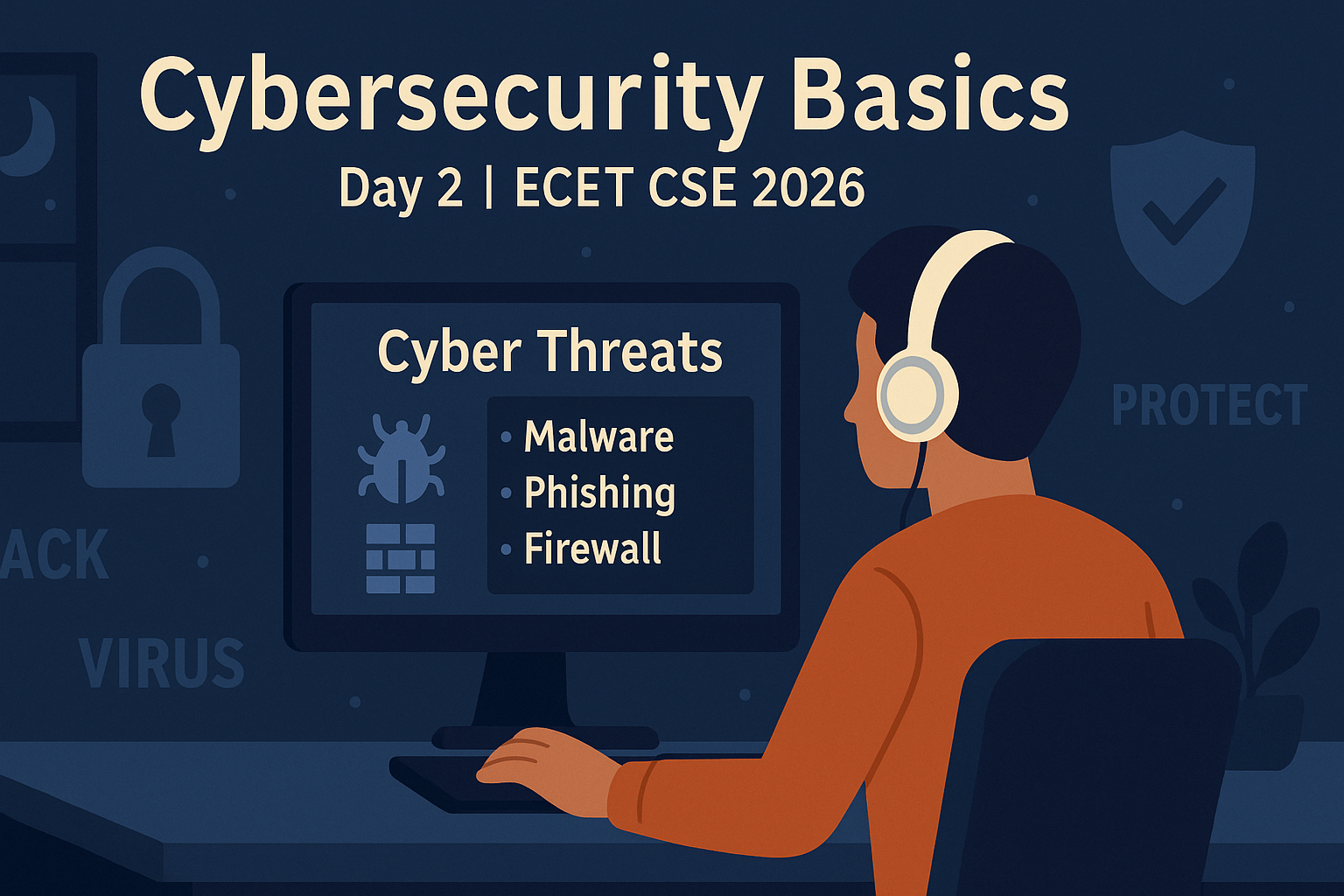
Concept Notes: Cybersecurity Basics
🔹 1. What is Cybersecurity?
Cybersecurity refers to the practice of protecting computer systems, networks, and data from theft, damage, or unauthorized access.
🔹 2. Common Types of Cyber Threats
| Threat Type | Description |
|---|---|
| Malware | Malicious software like viruses, worms, Trojans |
| Phishing | Fake emails or messages that trick users into giving personal info |
| Ransomware | Malware that locks your system and demands payment |
| Spyware | Secretly collects data from a system without consent |
🔹 3. Protection Methods
| Tool/Technique | Function |
|---|---|
| Firewall | Blocks unauthorized access to/from a network |
| Antivirus | Detects and removes malicious software |
| Authentication | Verifies user identity (passwords, OTPs, biometrics) |
| Encryption | Converts data into unreadable form to protect from unauthorized access |
🔹 4. Cybersecurity Terminologies
- Hacker – Person who tries to break into systems
- Cybercrime – Any illegal activity using computers
- DoS Attack – Denial of Service; overloads server to crash it
- Social Engineering – Tricking humans to give away confidential info
🧠 Cybersecurity MCQs – Day 2 Practice Set
1️⃣ What is the main goal of cybersecurity?
A) Speed up internet
B) Create websites
C) Protect systems and data
D) Install software
2️⃣ Which of these is a type of malware?
A) Firewall
B) Trojan Horse
C) HTTPS
D) Encryption
3️⃣ What does Phishing attempt to do?
A) Encrypt files
B) Repair systems
C) Steal personal info
D) Block websites
4️⃣ Which tool is used to prevent unauthorized access to a network?
A) Antivirus
B) VPN
C) Firewall
D) Router
5️⃣ What is the full form of DoS in cybersecurity?
A) Data on Security
B) Denial of Service
C) Device over Server
D) Distributed of System
6️⃣ Which is not a common cybersecurity practice?
A) Strong passwords
B) Opening unknown links
C) Using antivirus
D) Two-factor authentication
7️⃣ Which of the following is a cyber attack?
A) Stack Overflow
B) Bubble Sort
C) SQL Injection
D) Inheritance
8️⃣ What does encryption do?
A) Deletes data
B) Compresses files
C) Scrambles data to protect it
D) Backs up data
9️⃣ Which is an example of social engineering?
A) Asking for OTP by pretending as bank staff
B) Using a VPN
C) Installing Linux
D) Connecting to Wi-Fi
🔟 What is ransomware known for?
A) Boosting system speed
B) Encrypting without harm
C) Locking system and asking for money
D) Securing your OS
✅ Answer Key
| Q.No | Answer |
|---|---|
| 1 | C |
| 2 | B |
| 3 | C |
| 4 | C |
| 5 | B |
| 6 | B |
| 7 | C |
| 8 | C |
| 9 | A |
| 10 | C |
🧠 Explanations
- Q1: Cybersecurity’s main goal is to protect data, devices, and networks.
- Q2: Trojan Horse is a type of malware that looks harmless but is dangerous.
- Q3: Phishing tricks users into entering sensitive info.
- Q4: Firewalls monitor and control network access.
- Q5: DoS = Denial of Service attack, overloads a server to crash it.
- Q6: Clicking unknown links is dangerous, not a safety practice.
- Q7: SQL Injection is a method used to attack databases.
- Q8: Encryption protects data by converting it into unreadable form.
- Q9: Social engineering includes impersonation to get secure info.
- Q10: Ransomware locks your system and demands payment for access.
📥 PDF for Download
📌 Available in the Telegram group tonight:
👉 @LearnNewThingsHub
💬 Comment Task
🗣 Which threat confuses you most – Malware, Phishing, or Encryption?
Tell us in comments — and we’ll explain it with a real-world example in tomorrow’s short!
![]()



